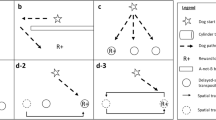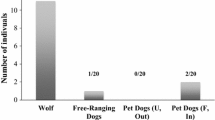Abstract
In this study I tested Benson Ginsburg’s theory that dogs should show diminished ability, compared to wolves, in orienting in three-dimensional space and manipulating objects sequentially. Dogs of all ages and juvenile wolves should do poorly on these measures, but at some time before sexual maturity, the juvenile wolves should begin improving to the level of adult wolves. Two adult and seven juvenile wolves were compared with 40 adult German shepherds. The initial task was to pull a single rope suspended from the ceiling; complexity was increased by the addition of ropes and by changing spatial configurations. Adult wolf performance was consistently successful across all tests and requirements. Juvenile wolves had little difficulty with one and two rope tests, but did more poorly in the three rope tests. The behavior of the dogs grouped into four profiles (# of dogs): non-responders (6), one rope (15), two rope (14), and three rope responders (5).









Similar content being viewed by others
References
Allen DL (1979) Wolves of minong. Houghton Mifflin, Boston, MA
Bakarich AC (1979) Comparative development in wolves (Canis lupus) and dogs (Canis familiaris). MS thesis, Trinity University, San Antonio, Texas
Bayer K, Range F, Aust U, Steurer M, Huber L (2009) The touch-screen method as an implement for dog experiments. J Vet Behav: Clin Appl Res 4:51 (Abstract 12)
Bekoff M (1974) Social play in coyotes, wolves, and dogs. Bioscience 24:225–230
Brower K (1989) Paul Paquet: wolf man of riding mountain. Wolves Relat Canids 2:15–24
Buytendijk FJJ (1936) The mind of the dog. Houghton Mifflin, New York
Carbyn LN, Trottier T (1988) Descriptions of wolf attacks on bison calves in Wood Buffalo National Park [Canada]. Arctic 41:297–302
Coppinger L, Coppinger R (1982) Livestock-guarding dogs that wear sheep’s clothing. Smithsonian 13:64–73
Coppinger R, Glendinning J, Torop E, Matthay C, Sutherland M, Smith C (1987) Degree of behavioral neoteny differentiates canid polymorphs. Ethology 75:89–108
Crisler L (1958) Arctic wild. Harper and Row, New York
Dixon JS (1934) Mother wolf carries food twelve miles to her young. J Mammal 15:158
Enloe LJ (1988) Problem solving and delayed response performance of domestic dogs (C. familiaris) and hand-reared coyotes (C. latrans). Unpublished manuscript, Idaho State University
Fentress JC (1967) Observations on the behavioral development of a hand-reared male timber wolf. Am Zool 7:339–351
Fox MW (1971) Behaviour of wolves, dogs and related canids. Harper and Row, New York
Fox MW (1978) Man, wolf, and dog. In: Hall RL, Sharp HS (eds) Wolf and man. Academic, New York, pp 19–30
Frank H (1980) Evolution of canine information processing under conditions of natural and artificial selection. Z Tierpsychol 53:389–399
Frank H, Frank MG (1982) Comparison of problem-solving performance in six-week-old wolves and dogs. Anim Behav 30:95–99
Frank H, Frank MG (1985) Comparative manipulation-test performance in ten-week-old wolves (Canis lupus) and Alaskan Malamutes (Canis familiaris): a Piagetian interpretation. J Comp Psychol 99:266–274
Frank H, Frank MG (1987) The University of Michigan canine information-processing project (1979–1981). In: Frank H (ed) Man and wolf. Dr. W. Junk, Dordrecht, The Hague
Frank H, Hasselbach LM, Littleton DM (1986) Socialized vs. unsocialized wolves (Canis lupus) in experimental research. In: Fox MW, Mickley LD (eds) Advances in animal welfare science 1986/87. The Humane Society of the United States, Washington, DC, pp 33–49
Fuller JL, Fox MW (1969) The behavior of dogs. In: Hafez ESE (ed) The behavior of domestic animals, 2nd edn. Williams and Wilkins, Baltimore, MD, pp 438–481
Ginsburg BE (1966) Social behavior and social hierarchy in the formation of personality profiles in animals. In: Zubin J (ed) Comparative psychopathology, animal and human. Proceedings of the American Psychopathological Association, vol 22. Grune and Stratton, New York, pp 95–114
Ginsburg BE (1978) The genetics of social behavior. In: Bateson PPG, Klopfer PH (eds) Perspectives in ethology, 3rd edn. Plenum, New York, pp 1–15
Ginsburg BE, Hiestand L (1992) Humanity’s “best friend”: the origins of our inevitable bond with dogs. In: Davis H, Balfour D (eds) The inevitable bond. Cambridge University, New York, pp 93–108
Ginsburg BE, Schotté CS (1978) Genetic differences determining the capacities for social behavior among wolves and dogs. Behav Genet 8:94 (Abstract)
Ginsburg BE, Slatis H (1962) The use of purebred dogs in research: problems of genetics. Proc Anim Care Panel 12:151–156
Gould SJ (1986) The egg-a-day barrier. Nat Hist 95:16–24
Hiestand NL (1989) A comparison of problem-solving and spatial orientation in the wolf (Canis lupus) and dog (Canis familiaris). PhD dissertation, Department Biobehavioral Sciences, The University of Connecticut
Hill BT (1981) Data base organization for behavioral research. Unpublished manuscript, Dept Biobehavioral Sciences, The University of Connecticut
Humphrey E, Warner L (1934) Working dogs. Johns Hopkins, Baltimore, MD
Iljin NA (1941) Wolf-dog genetics. J Genet 42:359–414
Jenks SM (1988) Behavioral regulation of social organization and mating in a captive wolf pack. PhD dissertation, Department Biobehavioral Sciences, The University of Connecticut
Kleiman DG (1967) Some aspects of social behavior in the Canidae. Am Zool 7:365–372
Lashley KS, Wade M (1946) The Pavlovian theory of generalization. Psychol Rev 53:72–87
Mech LD (1966) Hunting behavior of timber wolves in Minnesota. J Mammal 47:347–348
Mech LD (1970) The wolf: the ecology and behavior of an endangered species. Natural History, New York
Mech LD, Korb M (1978) An unusually long pursuit of a deer by a wolf. J Mammal 59:860–861
Medjo DC, Mech LD (1976) Reproductive activity in nine- and ten-month-old wolves. J Mammal 57:406–408
Morell V (2009) Going to the dogs. Science 325:1062–1065
Möslinger H, Kotrschal K, Huber L, Range F, Virányi Z (2009) Cooperative string-pulling in wolves. J Vet Behav: Clin Appl Res 4:99 Abstract 93
Packard JM, Seal US, Mech LD, Plotka ED (1985) Causes of reproductive failure in two family groups of wolves (Canis lupus). Z Tierpsychol 68:24–40
Peters R (1978) Communication, cognitive mapping, and strategy in wolves and hominids. In: Hall RL, Sharp HS (eds) Wolf and man. Academic, New York, pp 95–107
Peters R, Mech LD (1975) Behavioral and intellectual adaptations of selected mammalian predators to the problem of hunting large animals. In: Tuttle RH (ed) Socioecology and the psychology of primates. Mouton, The Hague, pp 279–300
Price EO (1984) Behavioral aspects of animal domestication. Q Rev Biol 59:1–32
Roitblat HL (1982) The meaning of representation in animal memory. Behav Brain Sci 5:353–406
Rutter RJ, Pimlott DH (1968) The world of the wolf. J. B. Lippincott, New York
Savalli C, Brandão MM, Domingues TS, Honório MA, Ades C (2009) Dog-human communication through a keyboard: is human attentional state relevant? J Vet Behav: Clin Appl Res 4:55 Abstract 19
Schenkel R (1947) Expression studies of wolves. Behaviour 1:81–129
Schotté CS (1988) The development of social organization and mating patterns in a captive wolf (Canis lupus) pack. PhD dissertation, Department of Biobehavioral Sciences, The University of Connecticut
Scott JP (1950) The social behavior of dogs and wolves: an illustration of sociobiological systematics. Ann New York Acad Sci 51:1009–1021
Scott JP (1967) The evolution of social behavior in dogs and wolves. Am Zool 7:373–381
Scott JP, Fuller JL (1965) Dog behavior: the genetic basis. University of Chicago, Chicago
Slade VR (1983) Individual differences in social bond formation of two hand-reared prepubertal wolves. MS thesis, The University of Connecticut
Stockard CR, Anderson OD, James WT (1941) The genetic and endocrinic basis for differences in form and behavior. Wistar Institute, Philadelphia, PA
Sutherland NS, Mackintosh NJ (1971) Mechanisms of animal discrimination learning. Academic, New York
Sweeney JR, Marchinton RL, Sweeney JM (1971) Responses of radio-monitored white-tailed deer chased by hunting dogs. J Wildlife Manage 35:707–716
Thorndike EL (1911) Animal intelligence. Hafner, New York
Warden CJ, Warner LH (1928) The sensory capacities and intelligence of dogs, with a report on the ability of the noted dog “Fellow” to respond to verbal stimuli. Q Rev Biol 3:1–28
Woodbury CB (1943) The learning of stimulus patterns by dogs. J Comp Physiol Psychol 58:317–320
Woolpy JH (1968) Socialization of wolves. In: Masserman JH (ed) Animal and human. Grune and Stratton, New York, pp 82–94
Young SP, Goldman EA (1944) The wolves of North America, part I. Dover, New York
Zimen E (1971) Wölfe und Königspudel. R. Piper & Co, Munich
Zimen E (1981) The wolf: a species in danger. Delacorte, New York
Author information
Authors and Affiliations
Corresponding author
Additional information
Edited by Stephen Maxson.
Rights and permissions
About this article
Cite this article
Hiestand, L. A Comparison of Problem-Solving and Spatial Orientation in the Wolf (Canis lupus) and Dog (Canis familiaris). Behav Genet 41, 840–857 (2011). https://doi.org/10.1007/s10519-011-9455-4
Received:
Accepted:
Published:
Issue Date:
DOI: https://doi.org/10.1007/s10519-011-9455-4




